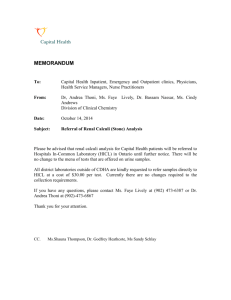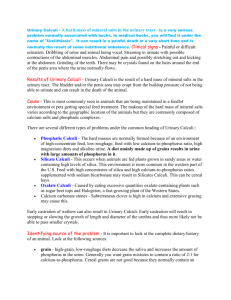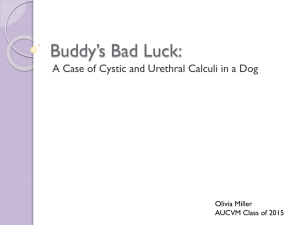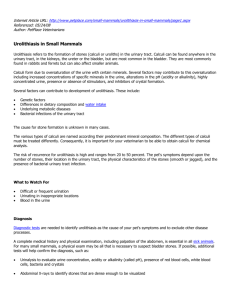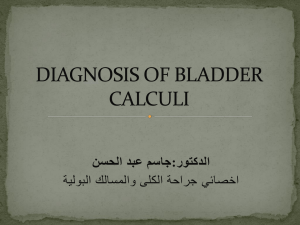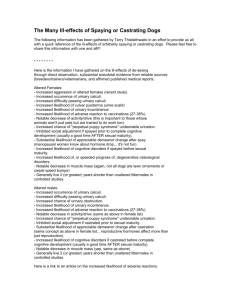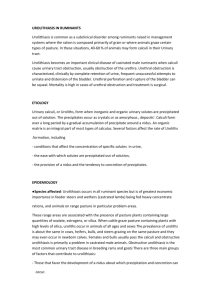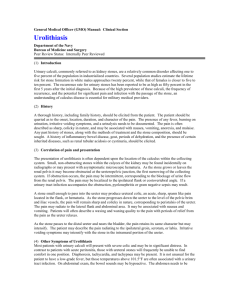Document 13490646
advertisement
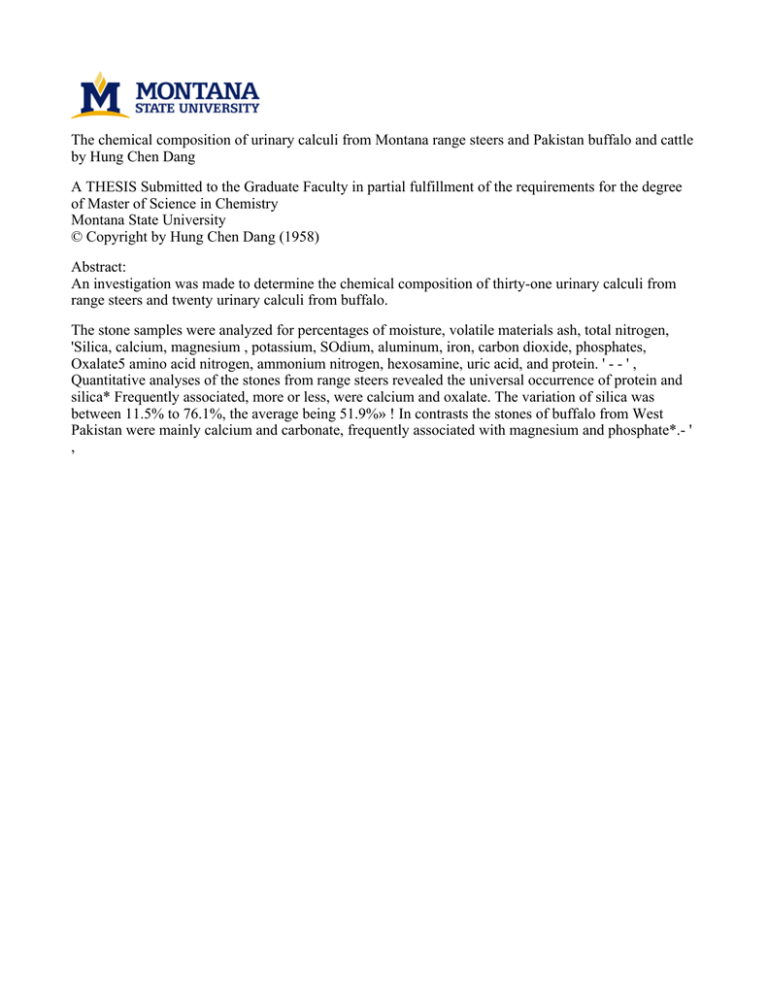
The chemical composition of urinary calculi from Montana range steers and Pakistan buffalo and cattle by Hung Chen Dang A THESIS Submitted to the Graduate Faculty in partial fulfillment of the requirements for the degree of Master of Science in Chemistry Montana State University © Copyright by Hung Chen Dang (1958) Abstract: An investigation was made to determine the chemical composition of thirty-one urinary calculi from range steers and twenty urinary calculi from buffalo. The stone samples were analyzed for percentages of moisture, volatile materials ash, total nitrogen, 'Silica, calcium, magnesium , potassium, SOdium, aluminum, iron, carbon dioxide, phosphates, Oxalate5 amino acid nitrogen, ammonium nitrogen, hexosamine, uric acid, and protein. ' - - ' , Quantitative analyses of the stones from range steers revealed the universal occurrence of protein and silica* Frequently associated, more or less, were calcium and oxalate. The variation of silica was between 11.5% to 76.1%, the average being 51.9%» ! In contrasts the stones of buffalo from West Pakistan were mainly calcium and carbonate, frequently associated with magnesium and phosphate*.- ' , THE CHEMICAL COMPOSITION .OF URimHY CALCULI FROM MOZItANA RANGE STEERS AND PAKISTAN BUFFALO AND CATTLE . by Hung Ohen OAng ■ ■ ■ A THESIS .Submitted, to the Graduate Faeulty " ■ ■ ■ . ' 1. . .. m : .■ ■partial fulfillment of the requirements ■ ■ for the•degree of Master of Seience in Chemistry at Montana StAie College Approved Chairman, Sbcawinlng Comfittee December. 1958 Na7/ 3) 2 i A o O r vo."LTABLE OF CONTENTS Section Page Number I. Abstract II. 3 Introduction 4 III. Review of Literature 6 IV. Materials and Methods 10 A. Sources of Urinary Calculi 10 B. Methods 16 V. VI. VII. VIII. IX. Experimental Results 21 Discussion 25 Summary 28 Literature Cited 29 Acknowledgments 32 133311 3 I. ABSTRAGf An investigation was made to determine the ehemieal composition of thirty-one urinary calculi from range steers and twenty urinary calculi from buffalo* . The stone samples were analyzed for percentages"of moisture$ volatile materials ash, total nitrogen, ■silica, calcium, magnesium , Pdtassiumj, . sodium, aluminum, iron, carbon dioxide, phosphates, oxalate, amino acid nitrogen, ammonium nitrogen, hexosamine, uric . acid, and protein* . ■ ' - ■■ ' . V: ; . ■ ... ' Quantitative analyses of the stones from range steers revealed the universal occurrence of protein and silica* .more or.less, were calcium and oxalate* Frequently associated, The variation of silica was „ between 11*5%. to-76*1%, the average Being 5l*9%» • In contrast, the stones of buffalo from West. Pakistan were mainly calcium and carbonate, frequently associated with magnesium and phosphate*.- , , 4 II. IIfPRODUGTION . One of the more troublesome problems which face the cattleman is urolithiasis, or urinary calculi, or commonly termed, "water belly=" Ecohomio losses of sheep and cattle, particularly range steers, because of this condition reach significant ■figures every year, especially dur­ ing the fall and winter when the disease is more prevalent= The fact is that urinary calculi are almost universal over the WOrld, though seme areas are -seriously affected and Some are not, and this problem is not only in their occurrence among the ,cattle and sheep, but also other sorts of animals= The etiological factor of urinary calculus formation and prevention in cattle has been the object Of a great deal of study= still remarkably confused. The subject is Many factors are related to the problem. According to the review of Newsom(I), various contributing causes hays been indicated: diets containing large amounts Of calcium, magnesium, oxalate, phosphate and silicon; mineral imbalance; vitamin A deficiency, hard and alkaline waters; bacterial infection of the genito-urinary tract; urinary irritation; hyperparathyroidism; .and diseases of, bones. Numerous - theories, such as improper pH of the urine, colloidal constituents of the urine, and nuclei for stone formation in the urine have been advanced and experiments have been performed in attempts to determine the causes of urethral calculi in cattle. outbreaks-. However, nothing seems to be consistent among Up. until comparatively recent times, little has been done t o , determine the Causes Of. calculi.among range steers. <4 Undoubtedly the cause 5 is multiplee . ' " To solve this problem, many suggestions; have been made. ^Howsveie5 .. the knowledge,of urinary calculi of cattle is net complete, and no sug- ... Iicient clinical data sSem to be at;hand, to determine•the extent to ,which : . • various therapeutic procedures are successful. To .prevent ,the ,formation of calculi^ maintenance of large water, intake, and,.output5'feeding ,low ash ■. diets with -adequate- vitamin M and protein* keeping;.the■ ■urine acid^ o^adir cation of infection from.the urinary tract, and correction .of metabolic, .'diseases, ,should -)qo- considered. The physical and -.chemical, shtudy of the....'.' urine and calculi .-may-piay one. of the important roles- .in- determining the ,, etiology of a stone, ,and may provide, a guide to 'management and therapy.. ' The purpose of this paper, is to quantitatively,.determine the,constituents of urinary calculi of. range, steers and of buffaloes for the purpose of.having a basis,for further studies, on their formation■and prevention. ' ■ Ill, BE?B W OF LIBRAfOBE As parly,as 189^, Kllmmsr,(2) made a.general mention of the chemioal constitution of urinary calculi of domesticated animals, and Law (3)» in 1908, discussed in ,a Bureau of Animal Industry report, the.problem of cal­ culi in cattle, He classed the urinary, calculi according to. their locality, form?, and chemical composition, namely. Coralline calculi,.pearly calculi, ' gneen .calculi, white.. Calculi, ammonium, magnesium calculi,; silieious^eaB ' ' .■ culi, Cxalateiof lime Calculi, and pultaceous deposits,,., fhe first, four ■ types,.mainly, contain the carbonate, of lime with some carbonate of mag­ nesia^ the fifth type _is ctimpesed of ammonia-magnesium1phosphate,chiefly $ # e Sixth type ,contains .silica,: the seventh, type is formed .pf oxalate, of lime; ,and the last type is the pultaeeous deposits, .and no chemical com•position was mentioned, . .■ . ... In 1910, Mchael (4) analysed a urinary calculus,from a shorthorn bull and' found the substance most contained was Calcium phosphate., By examining the kidney stones Irom a, cow fed alkali water, Larsen ’and Baily, .(4), 1913, reported the.composition was moisture 2,8$, organic matter 15,8$, silica 76,9$, Ga 0,08$, Hg 0,05$, and Fe' 0,006$, But they noted that the alkali, water contained practically no silicas In a study of.calculi in cattle, BloUnt (6), 1931, mentioned seven, types of calculi, They were Composed of silicates, calcium.and magnesium Carbonate, ,calcium oxalate, calcium and magnesium, phosphates, and iron Wbonata. .. , . . ... ... ... ... Ranganathan (7),. 1931s in India, analyzed twenty-three urinary calculi .. • obtained from cattle. ■ ■ ■ ; 1■ - 1 ‘ . • ■ ' \ • ■ ■ ■ , ■ Twenty-one were vesical and urethral stones and two 7 tirere:renal=- He found- the average- chemical composition was- moisture 3=1^ s, total nitrogen Qil$ 3 SfO kk*Q%p MgO 4o8%s,GOg 39=1%$ arid no uric acidc- In- the- same year,-. Rangnanathan (18) reported, a few types of' bovine ■calculi® These stones were largely nitrogen and phosphate but. no carbon dioxide. . WoodrUfI' (9 ), 1934*,in discussing the incidence of urinary calculi, in. f'eedlot cuttle^ stated- that the urinary calculi are usually composed ■ of calcium oxalate or calcium phosphate ■and uric acid* Iri 1935s.Aston (IG) reported two crises of calculi in Hew Zealnd * - One was chiefly magnesium^ammonium phosphate and the other was silica, calcium carbonate,-calcium phosphate, and cystine®, Mewgom (l), 1938, discussing the cause of Calculi with reference to cattle arid sheep, indicated that bovine urinary calculi are composed of calcium, magnesium, and aluminum salts of phosphoric acid. Beeson, PenCe, and Holm (11j, 1943, reported the chemical composition of four stones from sheep, arid -showed loss on ignition 17-19%,'silica ■ 70-78%, calcium 0-1%, magnesium 0-1%, iron 0-1*42%, and no phosphate® It is interesting that in 1947, Aldrich (IR) mentioned a rare renal calculus in a calf, two months of age* The kidneys were enlarged, and the medullary portions were filled with a white chalky precipitate which was .ammonium--, and sodium urate.* It was thought probably to result in the young animal from the decomposition of the nucleoproteins of the nucleated fetal red corpuscles*.. 8 ■ -Blacks ElliSj .and Jones (13), 194?» studying1the ■effect of limestone on the formation, of-urinary. Calculi in steers, found that■the■calculi disorder was aggravated:by the-feeding'of grain sorghum, but ho composition:of the stores was-;mentioned.;.' ;v .i . ' '' Hill (14),: .1950,mmentioned a case of urinary calculi in ah. aged bull \irith several'hundred'calculi In the urinary !bladder, ' The urine 'showed by microscopic examination numerous triple phosphate, crystals» but ho'analyses were made* ‘• '■ . ■> Mathams1and .Sutherland-(1$), 1951, analyzed the calculi from four affec• ted cows’ kidneys. Two•from one kidney'were mulberry-ahhped, hard, and '' brovmish~black, .From two other .kidneys, they obtained fibrousg, rather spongy,-- white to yellow.calculi, each of which, was composed almost entirely of silica, and. in the fourth kidney there was a number of hard, angular, dull yellow calculi,,consisting chiefly of 'silica, but’containing a trace, of calcium oxalate, . . -' ■ Swingle (16), 1953, studying the chemical Composition of urinary calculi which e,Sflie from 63 cases of occluding calculi in range steers, in­ dicated that protein -and silicon invariably,were present, and in'. 20 cases, these were apparently, the only components. Infrequently associated with these .two components were calcium and oxalate and occasionally magnesium. Only rarely were- ammonium carbonate and phosphate ions found, In a- study of the urinary ■Calculi of sheep,' Pvntriano (I?), 1955, indicated that they contained CaO 0,4# to 0 , 5 % B3O5 6.?4# to 0,82%, . Mg 0*15%, SiO2-62% to 75,4%, and ash, 74% to 82%, 9 In 1956, Bennetts (IB) indicated in the eastern districts of Western ■ Australia, urinary calculi constitute ■a serious -cause of mortality, fre- : quently Vith losses of up to 10% in rams«' .fhe calculi were Vostly silica and calcium carbonate, In '1957 Sutherland (32), in Australia, reporting on urinary calculi' in sheets indicated that- etiemical analyses'of calculi Showed that, they. ■ consisted chiefly of calcium carbonate (65$ to 98$) with a varying ,amount of magnesium carbonate (up to 24$), In the discussion section of the same paper, Bennetts mentioned that siliciou's calculi are found principally in sheep living on cereals, ' The ash is about 90$ silica, and there is very little organic matter. Young sheep' are more susceptible, and on some proper ties, losses in weaner' wethers may reach 3.0$* ■ • . it, M T S W i s .;m ..WHODs ';. A9 . Source of Stones . :. The calculi analyzed in this investigation were ■obtained from Dr. K0 Fo Swingle, Teteninary Research Laboratory, Montana State College» These stones were collected over the past few years'.by Swingle,. Of the' stones i# this-.stMy, -thirty^one calculi came from Cases'' of 'occluding ealcu-^ ■ ' ' -v ' ■ 11 aiaong range;Steehs in Montanh and, twenty calculi were from Dr0 Abdussalaiaio' College of Veterinary ,Medicine, State College of Washington, and were from -. 1buffalo and ..bullockso ' .• ,t The source and description of each of the stones.is listed ;in Table’I and. ,Table-Ilf. . '. '. " . ' I' . ... , . The Spupce and, Appearance -of Urinary, Galeuli from,Range, .gteers ,’'. 4 . ‘•r • • '' * ,* • • ‘ ‘ 1'• r ,, ' \• ‘ ’• -• • Serial Aoees-, .location locality Scnor .pate” of Gplor Hard- , Size. - Shape So, Stoai (Orgea) ' : , Collec-.... aes#' '(».)' ' ■ I I - ; • ■ • ' • ’ . • . .' • ‘ ^ t l O l l - I . 2612 .. urethra. .Mies, IoAo ,Jacob-,4/2l/45 City sen ' '' .; ''M1' 2 ' 2695 urethra Beehive Hertzler 12/4/45 3 2711 ^ kidneys' ■ureter .Ridge bladder urethra , ■ ■ ' ■ V ■ : , - » ... ' •. ;■ ;; -. . Jo Harris, 12/31/45 4 2721 urethra ,powder- .Ho Jones, :1/15/46 gray villa '5 2751 urethra Intake J0 Tomalino 6 2754-1 urethra Powder- To Brose 2/20/46 brown- raft ville ish 7 2759. urethra, Gamp ' JbBoCatron-2/27/46 brown- soft 3 x 6 flat ..Creek5/' ■ iak x 6 So Daki. • 8 2761 kidney Olive 9 2780-1 bladder 1/2/46 brown- soft ish . white 5 mulberry 5’ mulberry 5 lobed 3/4/46 whitish soft 2 x 5 chalky clips . Canyon Ge JohnGreek son 4/1/46 grayish soft 5 x 11 mulberry 10 .8780*2 ■urethra Canyon Ge JohnGreek son 4/ 1/46 grayish soft I to 5: granules mulberry 11 2902 urethra' Jfelyille GaBoCrum 1/8/47 ■whitieh soft Ig .2904 13 2925 ■ Sb Jfemow soft urethra Melville Tronrud urethra 1/10/47 brown- soft ish ‘ TostOn Be Kimpton 3/7/47 brown- soft ish 6 x 8 irregu­ lar lump 8 mulberry 5 mulberry 12 Table' !.Continued Serial AccesMo o sion # Location Locality .Donor’ (Organ) Date of Color Goliec-, tiori . 14 3180 urethra' Forsyth 15 3185 kidney ui'ethra, Bnnis bladder Mewhall 1/5/48 bladder & urethra Ennis. Newhall 1/10/48 urethra Martins- H0 Dump 1/17/48 16 17, 3187 3195-4 Hard­ ness .' Siste (nw) Shape C» Holland 12/31/47 Gale 18 3220 urethra Melville G0 Grum 2/13/48 . • 19 3696 urethra' Gamas J0 Welsh 1/6/49 20 3670. urethra Dutton 12/21/48 21 3771 Gold Greek urethra Fish tail Yates 2/16/49 22 4093 23 4134-1 .urethra 24 4205 urethra Billings 25 4259 urethra Town­ send 26 2605-1 urethra 27 2605-2 urethra urethra Stan­ Hughes ford ' Livestock Gds 1/28/50 ' Glen­ Q0 C 0 Hal- 1/15/50 dive ver J0 Kiiehei 3/17/50 soft 5 mulberry 'W«H»Koper 4/12/45 brown­ soft ish 3 mulberry W 0H0Koper 4/12/45 brown- soft i'sh 3 mulberry G0 Gakisch 3/2/45 light brown I-'-"' ' V — — INI I — — 13 Table I Continued Serial' Acces- Loeation Locality Donor No* sion # (Organ) 2605-3 urethra Date of Color HardtCollecness ■tion Size : Shape (mmo) !—Apsr WoHoKopsr '4/12/45 brown- soft ish' 3 .mulberry . 29 2605-4' 'uretlira — - ' l/i/'oHoKoper 4/12/45 brown— soft 3 mulberry . . ^ 1 . - : ... . . ' ish ;■ 30 2605-5 urethra 31 2605-6 urethra --r— r— - WoH«Koper ' 4/12/45 brovm- soft ish . ' . . . •: ,W»H».Koper .4/12/45 brown- soft, ■ 3 mulberry ish ' . ■ ' . ■ ' 3 mulberry 3.4 •TABI1 S Il The Source and Appearance of Uroliths from West Pakistan 'lahore 2 buffalo kidney lyallpur bladder 3 bullock bladder lahofe 1953 6/11/53 yellow- hard 5x6 ish . I buffalo kidney Hard- Size ' ness (mm,) I ■I Color Sirr4 ; Serial Animal location •Locality Bate of No*- Species (Organ) Collecf;.' , .... .. .■ i. . '. . ' tion,. Shape smooth' surface, spherical smooth surface, spherical 0/24/53 yellow-hard 5x5 smooth surface, ish 4 buffalo kidney' Lahore bladder, 0/16/55 5- buffalo kidney Lahore 6 bullock kidney lyallpur 7 ‘ 5x3 smooth surface, spherical 1953 gray-, hard 9x13 ish smooth surface, irregular 1953 . brown— hard ish 5x0 spherical . buffalo kidney Lahore bladder" 0/7/53 white —— granule. 6 bullock bladder 2/0/53 yellow- hard 2x3 ish ^ smooth surface, spherical 9 donkey dull white Lahore salivary Ghoa- ■' 1953 duct SaidenShah gray■ ish spherical. hard soft soft — chalk-like '■ yellow-hard ish — gravel 10 bullock bladder Lahore 7/4/53 11 buffalo bladder Lahore 1/20/35 dull soft — — 'granule white 12 13 buffalo kidney Lahore 1953 buffalo urethra Shelkhup-* 3/2/56 ■ ■" •;ura yellpw-hard ish — granule yellow- hard 5x11 smooth, . ish spherical ■ 15 Table II Continued Serial Animal Location Locality Bate of Color Hard?- Size: Shape . Mo. Species (Organ), Gollecness (mme) ' ____■ , ■. , , ■■ tion ■■ 1 . 1. _______ . ' ■ bullock bladder Lahore 4/15/53 16 bullock bladder Lahore. 43/8/53 17 bullock bladder - Lahore V ■ 2/8/53 ■ f'. :r. • ie bullock bladder.,Lahore ‘4/8/53 19 buffalo bladder Lyallpur 20 bullock bladder Lahore yellolf- hard """ ish : smooth, spherical ’3 spherical, pear1-llke gray-Vi’-soft ish 2 spherical, 'pearl-like gray- soft ish 2 .spherical, •pearl-like n 11/53 & 15 Lahore■ f buffalo kidney: to 14 grayish soft .2 .spherical, pearl-like 6/11/55 grayish soft 'a' gravel. - grayish soft 2 spherical, pearl-like '4/8/53 .16 Be 1 Methods, and Procedure ■During the .study, of methods for determining the chemical composition ‘ ; ■ * * • • . J ■ .of the calculi i, the first considerations were the amount of samples and [suitability of the methods. ' Some,of'the stone^ ''were ‘quite-small'sti that ■ it kas very-difficult to determine all of their. Qpnpositiom .v ' The methods detailed in this paper"were micro-methods and' semi-micro-' methodsb Some procedures used in these analyses were developed-and tested .by Dr6 Swingle.. Biochemistry Section,,;Veterinary'Research. Laboratory' of '' i' * .■ » / . -1 > Montana State- College* ■ ■ ••■" V- ■' : ‘ .I In preparation for chemical analyses5 each of the. air-dried stones ' : ' ^ ' d\ . '' ' ' . . ■was ground to a. very fine, powder in a mullite mortar. The samples for : each determination Were' weighed on a microbalance, • Fof the determination -of moisture, volatile material, and'' ash, thd ; :■ ' ■’ ; powdered,samplea;were weighed in a small.platinum crucible.and dried in a vacuum, oven for one hour at SO9B* Cent moisture. The loss in weight, is reported'as per After weighing the crucible which contained the dry:sample was put in a muffle for an hour at 750 C,; the loss'in weight•represents volatile materialst and the residue is ash. The total nitrogen determination of the stones was .carried out by a modification of'the miero-Kjeldahl steam distillation method of Bodgers and Harter (19), The sample was placed .in a Kjeldahl flask of about 100 ml, capacity, A few drops of saturated copper sulfate and saturated 'potassium .sulfate solution, followed by 5. ml, sulfuric acid (28 S )P were ' added* The flask was heated with a small flame, then boiled at full heat until digestion was Complete*. After.cooling, the solution was diluted to 17 10 Uilo with water o , The fl&sk cpntaining the dissolved sample was attached to the distil­ lation apparatus and 12 ml, of sodium hydroxide (10 N)/was added slowly from the side tube without mixing the two layers. After attaching the receiver* the layers were mixed and distillate was Collected in dilute sulfuric acid (0*01 H) for 10 minutes after the distillation started, ,Fifteen ml. of HesslerfS reagent was added, and the solution was diluted to 50 ml. with distilled water. It was then mixed well and the trans- mittanee measured at wave length 420 mu, in the Coleman spectrophotometer and the results compared with a standard curve-,. ■ Silicon was analyzed by the micro-method of Swingle (unpublished). Powdered stone (0.5 to 1,0 mg.) was mixed in a micro-platinum Crucible with 0,5 ml, of an aqueous fusion solution containing 5 per cent-potassium carbonate and 5 per cent 'sodium carbonate* evaporated to dryness under a heat lamp* then ignited for five minutes in a muffle at 750%* After cool- ing* the crucible containing the fused mixture was filled about three? fourths full of water and set on a hot plate. :i The fused cake was taken- up ' ' . by adding I ml. of buffered acid molybdate solution and transferred to a . 50 ml. Volumetric flask, After development of the siliedmylybdate and phosphomolybdate color* it WAS- treated with 2 ml, of tartaric acid sdlution (10 %) to decolorize the phosphomolybdate and diluted to 50 ml. With water* 1Immediately after mixing the diluted, solution* the optical density, was measured at wave length 3?S mt/. The concentration.of silicon in the Unknown was. read by,comparing its corrected optical density with a stand­ ard curve* ... The.oalcitgji, magnesium, sodium, and potassium were determined by U'sirig the Beckman .DU spectrophotometer with a hydrogen flame attachment ,(^0), TheiStandard wasimade up ,in solutions containing approximately ■tjie quantities of the components present in the- .stones, .; oxalate, was -analysed, for dceording to .grown (21), .The stone- , '.PP1^ er.Whs, treated, with sulfuric, acid, heated,:and- titrated with''stand-, ' ard potassiw-permangante. at 607 # % » . t .. . •„ , / • . '. The carbon dioxide determination ,was.carried ■out',by a.:micro-method :using the. Warburg equipment,.. One milligram of sample was weighed' into■the Warburg’s-,flask .and 2,3 ml; of water added. 'Paa put 0,2 ml, of I M.lactic acid. In the side chamber The apparatus was .equilibrated in- a:water bath at constant.temperature,.then the lactic acid was tipped into the sample. From the final Constant reading of the manometer, the carbon dioxide, was calculated by. correcting for .pressure,.'.temperature,- and volume of. the flask, ; , . .... - • . ; The alpha-amino acid nitrogen was determined by the ninhydrin method ' 'according to Yemm and Docking (22) and using glutamic acid as a standard. 'In this procedure* the proline and hydroxyprolihe were not determined, . Phosphorus, was analysed according to the ascorbic acid method- Of Chen, Tqribara,-. and Warper. (23), The presence of. arsenate interfered in ,this determination, .Bight micrograms of arsenic are. equivalent--to I- microp-am of phosphorus, but in these samples- of calculi, arsenic was absent. According to the author, silicate in amounts up to one milligram has-nb effect. .. ■ - - . . Iron analyses were carried out by the 2,2’-dipyridyl method of Bothwell and Mallett (24). The error In measurement' may be;relatively greater with low ■concentrations of ,Iron^ but'.this method- was sensitive enough to,allow for moderate accuracy of,0*0$ to 0.5Q;per cent* Aluminum, was determined according,to Banerjee (2$). by an aluminon method. Using, the recommended procedure from 0-02 to X per cent alum- .■ ...inpm could be determined* . v ■ The ammonia.nitrogen,was analyzed, by a modified misrodiffusion method according to Mayer, Kelley, and Morton (2$), For determination■of hexosamine, the stones were hydrolyzed .with hydrochloric acid .(3N) at ISO0C* for. 4 hours, followed by removal ,of. HCl in a- vacuum dessicator* The .analyses were carried out with the ' modified Elsoh-Morgan method of Winzler (26),. and also checked with the acetic anhydride method .of Hoseman and Daffner (27). ■Due to the .effects of many factors, such as temperature,- heating time, concentration, pH, and constitution of stones, the results- of this determination were found to be highly variable and the results may be. in error* The method for determination of uric acid was that of Norton (28). It, is based upon the reaction with arsenophosphotungstic acid, reagent in the presence of cyanide ion* Eor analysis of ,sulfur, the stone powder was heated with fuming nitric acid and precipitated with dilute barium chloride. After centri­ fuging, it was compared turbidImetrically with .the. known.standards * Be.cause of limited size of the..samples the sulfur content may not,be aecurately determinable* SG £ine and lead were detected by the method With dithi&one and' r'esorcinal according to Feigl (29)» - Proteins were detected by the method of Swingle (46). ?ha per.cent protein used in the. calculation was obtained by subtracting,the non­ protein' •nitrogen- from the.total nitrogen:and multiplying by the factor • 6,25. ' ' For determination, of density of Stoness they were weighed in air.and •■ = in water and Calculated by the following formulas d = „ - . -. . ^air “ ^water .21 Te Experimental 'Results- In these' experiments5..two series -of urinary calculi were -analyzed*--. one was-from range steers and the other was from buffalo* can be seen in Table III.and Table IT, The;results; In.these two tables, it is very clear that the compositions of the stones can be grouped into two dif- : ferent kinds,. . lSteei1' stones mainly consisted Of silicon and, protein, associated more or less with calcium and oxalate, while uhe buffalo . -- stones mainly consisted of calcium^ carbonate, and magnesium. There were silicon and protein in every steer stone.. The quantity Of SiO2 ranged from-11,$ per cent to 76,1 per. cent, the average being. 52,8 per cent# These distributions are listed in Table V. Stones with 40 per cent of SiO2 included about 80 per cent of all-stones tested, and 61 per cent of the' stones had 50 per cent or more of SiO2' Table V . Distribution of Siliea Levels 'Among Calculi Nol of Stones Percetttagg of Total Steer Stones . 3 10 I 3 2 6 6 19 50 - 60 7 23 60 - 70 6 19 8 Range of Silica 6 .19 0 1 10 - 20 30 - 40 i 40 - 50 . ■■ TABLE III ' . ' ' ■ '; > the Shemieal Gomposition of Urinary Galeuli from Kange Steers (As percentages of air^-dry samples) ' -Stohe. Hois- VoiaHo,. t’ure 'tile Ash 1'. < , :4Q9ajL ' Hitrbi Sen'1 ' ,... , --V ■ ■ i 't;- ■. OaO MgO HagO C02 P2°3 "Oxal­ ate. FegO3 AlgO3 1( 71.49 1.69 60.88 74.37 2,46 60*58 1,63 63*81 •4*09 O6OO 0.34 44.30 1448990.36 0*47 68,56 2,13 6.42 lv.55 37*82 17*37 0.43 0.38 0.64 0,36 0.64 0.24 OiOO Oi96 0 ,0 0 0,00 0.46 0,43 0-.45 0,00 1,68 28,33 1.57 45*99 2*23 46*40 1.71 ■. 31.10 69*99 3*13 52,47 1.79 51*37 3*18 67,19 2=73 1,08 0*00 1,08 67,25 26.29 22 =3000 =Si 0.17 32*89 16*00 0*43 0.73 49*27 17.01 0,00 0 A 7 0,00 0.00 0.25 0.00 0.00 6*60 0*00 0 .0 0 0.54 0.00, 0,00 0.37 0.04 0,00 0.06 0,00 } 4"-. 0,00 Oi05 0,08 0,00 2780-1 2780-2 2902 2904 2*25 54«4# 2*46 58,19 1*78 ■ 23,83 1*99 36.75 43*31 39b35 74*39 61,26 17.69 16^13 70.47 47,73 0*56 0i47 Oill 0*44 0 .0 0 4.19 OiOO 0.00 0*66 0.29 0.09 1.03 0,04 0,000,06. 0.00 2925 3180 3185 3187-2 1.93 1,73 1.55 1.18 62*62 2,66 64.63 3,48 76.26 2,64 80.6? 2.38 49^87 11.15 0.22 0*36 52.71 10.51 0.21 0*41 2,25 0 .00 0*69 70.11 72,96 1*15 0.75 0*99 0,27 0 ,00 0126 0;*98 0,00 1,17 0.90 1.99 0,00 0*25 0.37 0.00 0.00 0 .16 , 0.00 t,COQ4O06 0.18 0.00 0,00 0*07 3195-4 3220 3696 3670 1.41 • 35*09 63*50 4*33 1,10 37.31 61*58 3*34 1.44 34,18 64.38 2.64 1,21 30.9T 67 , # 2,00 57.51 50,24 53*63 56,87 3771 4093-1 4134-i 4205 2,43 2,25 1*86 1,91 27,17 30,06 16,81 26.25 70,42 3,02 67,69 2,22 81,33 1,91 71.84 2,20 52*79 12.51 0,00 59*39 4*24 0*35 76.10 2*80 0,80 60.52 9.02 0.00 0,38 0*57 0,17 6*78 0,00 0 .0 0 0,42 10.00 0.15 4,66 0*00' 0.06 0,14 1.19 0,28 0,00 0.00 0,78 0.00 0.08 I 0.21 0.00 0,00 0.06 0.00 1.73 0.37 0.00 0*47 0.00 0,30 :0.05 0,00 0,00 0.00 0.07 4259 2605-1 2605-2 2605-3 2,'29 1*37 2=02 1,08 39,07 44,06 32*90 21*46 58,64 54*37 65,08 77*46 46,93 8,60 0.37 11.51 37.16 4*75 61,18 0*96 69*61 4 .0 4 0 ,00 0*64 0,43 0,32 9*73 0,00 0.49 0,00 0.00 0,00 0.16 <0,00 26,22 a2i.v0.00 1*49 — — 0*00 0,00 0,1? 0,0? 2605-4 1*95 2605-5 1.65 2.605-6 1,87 23*01 35,53 22.55 75.04 1*85 62.82 2,88 75.38 1*74 70,23 49*48 73,25 3*37 0.00 9*77--- 1.01 0.33 0,00 --T7W — — 0,14 f0.05 32*76 65,46 2*49 52,81 8.74 0,53 26lg 2695 2711 2721 4.96 1,79 2112 2*42 2725 2754-1 2759 2761-1 Average 1.78 26*55' 37:33 23i51 37,00 35.45 33,64 22.19 I8.15 3,a 4*71 3*47 i.S9 1.86 0*95 1*76 1=81 23.20 ISi55 1.10 6,89 3*44 8.58 7.83 8.83 1.01 0,30 1.47 0*48 0,00 0,47 0,56 4*82 ©*33 O .27 0,32 0.26 1,14 0.69 0,00 1*04 0,71 0,22 0.00 0,22 0.00: ■ 0.00 m G2°3 -.Amino- Hexosamine .SO3 3 . :.h 6*13 0,00 0. 72 , 2.64 trace0.00 2,35 0,00 0.00, 2,83 O6QO . 0.87 ■ . 2.19 0.00 0,00 - ZLiQ? OiOQ . 0*75 . 2.15 0.00 0,00 2U32- Q6OO , 0.40. 0.00 1.34 OoOO . 0,00 ■ 31,91 0,00 . 0,00 2926660*00 0.00 8,20 0.00 0,28 . 0.00 0.00 0 .10 , 2.36 , 0,39 , 0,77 , 0,85, . 2.26 „ 3.00, . 3.82 , 2.60. PbO 0.00 0.00 0.00 10.56 0,00 9.63 0.00 15.38 0 .0 0 .10.19 0.00 0.00 0*00 0,00 O6OO 0,00 0,00 0,00 E^otain ZnO 0,00 0.00 0.18, 0,00 ,0 ,00 0,00 0.00 19,56 0,00 11 .1 9 . 0 ,0 0 . 19,50. 0.00 17.06 Iotal»- 88.03 94*73 94=14 89,92 92,5394.29 97,95 94.09 31,03 OS© . 1*07' 2.03 0.00 23,12 000, 1.69 . 1.75 0,00 2.40 0,00 .1,01 3.81 0.00 11.68 Q»oq , 1,02 , 4,59 ,trace . . 0.00 0.00 0,00 ' 20.06 0,00. o,oo 0,00 29,50 0,16. 0.0Q 0 .00 21.37 0.00 0 ,0 0 . 0.00 11.81 96.36 96.66 9 7 *92 ' 87.05 10.36 o.oo 1.03 3.58 0 .00 Q.$6 0,00 1. QQ 3.24 0..Q0 3 .69 0 ,00 , 0.68 2,25 , 0.00 .1 .4 0 o.oo . 0.63 .2.05 .0,00 048 0.26 0,00 0,00 0,00 0 ,0 0 . 0,00 0,00 164.9 21,37 90*77 93.26 16.50 9&*51 96.0,56 ■ 0,00 4,78 0,00 .1.21 6,00 ; ii.G>5 0,00 , O .64 0.20 8.-22 0.00 /Ob95 ‘0 ,00 - ■ 13.36 0.00 , O.46 0,18 7*96 0,00 0,20 • 9075 0,00 •0 ,0 0 . 1.69 0.43 0.00 2.96 0,00 0 ,0 0 0,12 O=OQ 0,20 Brie aeid 111.82 2,27 1.08 1,43 0.00 0,00 0,00 0.00 3.14 0.00 0*84 —— 4,31 ,4.91.0,00 , ,0 ,0 0 . 0,00 . 2.08 .trace , 0,00 0.00 ,2,84.0,00 0,00 0,00 ,1,95 ,trace 0 .00 0,00 . 0,00 .0456 ^0,00 t 0,98 ,3.54.0,00 . 0,51 1.64 ,O.OO ,1,87 .3.55 trace 0,00, 0,00 OsOQ ' ,0.88 ,2.94 0.00 Q.19 1,06 — ;G .43 !. 2 ,74 , ,0*97, ,,.3.89 . 0 .7I ,3.64 „ — 0,75 ' 2.68 --0,85 '2.82 , . 0.00 0.00 0.00 0.00 14.87 0,00, 27,0.6 95.22 20.87 . 97.23 0,00 16.50 93.99 0,00 12,50.. 94.67' 0.Q0 0,00 18.87 95*37 0.00 13.87 - 92*56 0.00 9*8% 94,48 0.00 13.44 88,85 .045 0,00 0.00 0.00 0.00 0,00 0.00 11,63 0.00. 0,00 5,94 0.00 0.00 11,00 21.31 82,70 90,80 78.05 88,44 .11*56 18.00 91-45 82.95 10,8? 90.30 ' ' 0.71 0.23 *T#al is the Shm of moisture, SiOgs GaO-i MgQs Ha9O9 K9O, GOg, PgOg?,Fe20 3 9,AlgOg, ahd protein* ^ ^ * TiiBIS If The Chemieal Composition of Urinary Calculi from West Pakistan■ (As percentages of air-dry samples) , , 4 0*97 0.89 0*79 0*63 3 ■6 7 8 0*43 .46.54- ,53*03 1*82 .,45.99 .52.19 3,16 60*01 36,83 0.41 .43.79 ■55,80 9. 10, 11 12 0.43 )32.98 !66*59 1.08 39*56 .59*36 1*33 ' 39*23 59*44 0*89 ,39*73 59*38 k 3 13 14 15 16 42.31 .56.72 43.73 .55.38 46,39 52.82 .44.73 '-54*64 TotalNitro­ gen SiOg CAO 0.46 0.26 0,39 0*24 0.32 46*25 0*24 45*14 0*36 40.58 0*38 46.77 MgO 6.43 6.65 8 .70 5*68 0.26 0*22 '44.05 6*07 0*38 .0*27 39*39 9*26 3*10 0*43 2.57 24.71 0*31 2,10 42*77 ;8.$5. ■ ; 0*22 0.16 58*01 6*01 9%49 0*65 47*97 . 6*48 0*32 1*11' 50*30 3*16 .0.48 0,17 37*15 9.10 1 ,1 0 .37.91 >60.99 .0*45' .0*95 - 36.18 ,62.87. 1*36. : 1.26 35,47 63*27 0*31 1.01 ,36,16...62.87 , 0*i39, 0*00 47*93 8,61 0*17 44.95 11.55 ,0*3@ 52*87 4,20 0*OQ 36*58 .8*47 Na2O o;u 0,00 0.23 0.35 41g0^ 1.02 38.07 1.02 38*25 1.36 37.443 0.96.39,68 0.63 , 9*48 0.65 0*38 1*13 ■ 0*21 0.78 0.14 Oxal, ,, ate Amino- Hexos- • OgOj NHg ■ N . amine- SO^ 0*00 0,65 0.00 ' 0.09 , 0,00 0.60 0.00 0.03 0.00 ■ 2,19 6*00 0,04 0,06 0.52 0,60. 0.Q2 , Average 0.94 except No* 7 ■, 40.97 ^ 58.09 0*40 0*40 0.47 0.46 0.43 7*36 trace 0,00 0.00 0,00 0,00 Ot 53 6,00 0.84 0.00 0*00 e.00 , 0*53 6,00 0.00 0.65.33*78} 1.02 0,18 0,81. 33.05. 2.05 0.13 1*29 34*14 Of#, 0.21 0*00 35.72, 0*83 0*06 0*07 0*00 9,15 0.14 0,12 0*30 0*00 ^ 5 0.00 0*00 .9*14 '\ .0*19 41.21 .6*46 0,00 0.95 38.74 1.09 i0*10 0*00 44*99 4*97 0,10. 0.34.33*98. 0 .3 2 45*34 8*49 — — 32,96. 0.18 45*65 10.94 — f— 31,e'81, 1,27 0,38 46.20 0*00 0.00 0,00 0*00 0,28 0,00. 0.26 0*00 1 47 ■ 0.89 :48.35 .-50.76 18 0.74 -4.0,28 .58*98 42*41 56.70 19. '0*89 1.26 . ,36*82 '61*92 trade 0.00 0,00 0.00 0*15 0.60 27.21 1 .40 0*08 0.64 35,64. .1*06 0,00 0*64 37.71 0*90 0.00 1.12,34*35, 0*92 0,00 0,12 , 0.84,35*48. 1.10 ! 6 T3 ' 0.08 . .0.00 0*07 . 0 .5 4 0,05 , ■0 ,4 1 0,02 , 0,06 , '— 0.02 . 0*90 0,03 . 0,89- 0,0? , 0.00 , 6.00 0.00 -0.00 6100 .0.00 0*00. -0,00 0,00 ■0.00 0 ,00 . 0.OO 0.52 0,00 0*07 0,o48 3.25 0,35, 0,00 , ©*oo 2.49 0.00 %n0 trace trace 0*00 trace ,9*12 40.18 01000 0.42 5*52 0,64 Uric Aeid 0.53 0,00 0.52 0,00 0,00 1.03. 41*60,. 0,66. 9*00 0*17 1,17 35*35 .1.27 I0.08 0,22 7.63 33114 33.57 0.00 0.31 0*75 35.60, 1*83 0*00 I8 Mois-■ Vola. .ture tile , Ash .J 0 Stone — •a— HR — — .. ■, , ;. s— , - T i x n ^ P-. 0.05 . 0,06 . ' "■ r'» 0,03 . 0,63 . 0,04 ■ ' L 0.12 0,80 m Wfmwmsm 0,00 0*00 . ■2 .87 ’- 97.80 1*62 ■ 95.44 . 2*44 95.43 - I. 50 97*45 , 0*00 11*37 3 06 2«QO 3,00 GvOO * . r . ' ■0,00 0,00 0*00 0*00 0,00 0,00 0.00 0,00 Total 0,00 ,0.00 .1 .6 2 . '0.00 •OoOO 0.44 , 0.00 ,0*00 , 6,93 ., 0,00 0*00 •1,94 ■ ,, 2*81 4 ,25 *1,94 -■ 2.44 • . ■ - ^ c m m ___ 1- 96.32 93.00 90.37 95.32 96.15 .97*56 97,48 97.23 97.14 98*99 „ I . Proteln - PbO 97*60 94.40 1 2*50 2 .50 . 2*94 .2.87 92*13 89.04 92.13 93.98 2.32 95*50 - , . 0,05 f 22 , The percentages Of OaO ranged from 0.9 to' 23.2, and oxalate was also found jin eVeny stone,, the quantities ranging from 0,8% to' 31.0%„ ".They ' are listed as follows in. Table VIf . . ■ •_ . '. _ .Table ,VI. ■ -• -V ... 1 '• ’ Distribution of Galcium -and OJtalate levels Among Caleuli Bange of OaO- Percentage of ■ . '— .... Steer Stones ' , 0 -5 5 - 10 Range of Oxalate: .percentage“of . (%) steer Stones 40 ! ' 23 10-20 0-5 48 5-10 16 10 - 20 27 20 - 30 7. 20 - 30 16 ' 13 30 - 40 3 30-40 6 - y. . There were eighteen stones with small quantities of MgO, but only four-stones had as much as one per-cent. and, calcium always occurred together. sodium and potassium. It was found that magnesium All of the stones had a little About 11 stones had carbonate, and the average was 0.71 per cent, but only one stone shewed high calcium and carbonate (with 11 per cent silica)* Phosphorus was found in fourteen stones, but the quantity was mostly under 0.5 per cent. Iron and aluminum were Seldom seen, Ammonia was found.in only one stone. magnesium and phosphate. It was found together with This was the. only steer stone formed of mag­ nesium. ammonium phosphate. Amino acids were present in all steer stones, as was also hexosamine,. 23 ' W n the non-protein .nitrogen is subtracted from the total' nitrogen, ' the. quantity of protein so calculated ranged' from 9 to 29 per cent. ' The aferage was '15.4 per.cent. • ' A small amount' of. uric acid was found in five stones, •but no Zinc' nor leado. ■ ■ In fable I?, all of'the buffalo stones are-seen to.contain CaO, MgOjl and OO^» The average amount, for CaO is 46.2 per cent, for MgO is 7,4 per, cent,, and for GOg is 35=5 per cent. .In those stones, only one was high in magnesium, phosphate, and ammonia, in. which MgO was 24,7 per cent, PgO^.was 33,6 per cent, and Ntk was.2,5 -per cent, .There ' was thus only one. magnesium ammonium phosphate calculus in this seriesj the rest were calcium carbonate and magnesium, carbonate ^■.• ■ ‘: ■' .. Sodium, potassium, and phosphorus were always present•in the stones. Iron was found in twelve stones out of twenty,- and only' eight•stones had aluminum, ' ■ ..., ■ All of these stones had no uric acid, zinc, nor lead* A comparison of the mean composition of steer and buffalo stones is. given in Table VII, Table YII Mean Composition of Two.Classes of Calculi Type Mois- Yolaof ture tile Stohe,. . Material Pro- Dens— Ash Total SiO9 CaO .MgO •Sa9O . S . * . %. % % Steer 1»8 32« 8 65=5 2.5 52.8 8.7 Buffalo 0.9 41.0 58.1 0.4 0.4 . K9O CO ^ % ?205 2^3 A1203 ■G2®3 'Ity % 0.5 0.7 0.2 0.7 0.2 0.02 0.07 9.5 15«4 1.18 46.2 7.4 0.1 0.7 35.5 1.1 0.13 0.12. 0.8 2.3 2.43 ■7 25 VI« Discussion Concerning the experiments just mentioned, the limited amount of samples and the other.constituents of the stones led to interferences in the accuracy of some of the methods, so some of the components may have .been missed* - It.is interesting that the tables which listed the chemical composi­ tion of the stones give us a.general idea that the calculi from buffalo are mainly composed of calcium carbonate, magnesium, and some, of iron and phosphate, and the calculi from fange steers are mostly silica, protein, '• * * " and calcium oxalate * ... With regard to the factors, which have been suggested as possibly involved in the (!development of urinary calculi in cattle, the limited consumption of water, vitamin deficiency, mineral imbalance,-and bacterial infection may all be considered* Though the study of the relation of limited water consumption to development, of urinary calculi in steer's by.Swingle and Marsh (30) showed no evidence of. any interference with the passage of urine through the urethra, the urine; became so concentrated that it was not able to hold, all the solids in solution, and they were at.once precipitated in the solid ..form, a condition possible^ favorable for stone formation. In connection with the formation of magnesium ammonium phosphate,; ■,, ■ ■ " 1 ■ ■.: ' 1 ■7 the presence of magnesium aind phosphate.in the food or Water results in " / , , the phosphate of magnesiumtS being excreted in the urine and meeting the ammonia there to form the ammonium-magnesium phosphate, which is insolu­ ble, The common source of ammonia is from decomposition of the urea in 26 fWmenting uptoeii' in this ease, the presence .of= bacteria- to ,the .urine . is essential,',and the bacteria are a most'important factor-in.causing. Ieposits in the tirine«- Range cattle do not usually get.sufficient phosphate, to the forage to cause phosphaturia, so the.ammonium-magnesium •phosphate calculi 'are1riot common.Another insoluble salt which1appeared frequently in the urinary calculi was carbonate of Iime0- This■is derived mainly from.calcium to the food, water,1 and Soil, The calcium bicarbonate in the blood passes into the urine, and,' if the urine is sufficiently alkaline, may precipi­ tate as calcirim -carbonate, I less abundant constituent of urinary calculi in cattle, is cal.clum Otolate0 In these' calculi oxalic acid"may have come frbm. the ,feed*' AriOther inorganic substance found in ,steer calculi is. silica# .In general silica is a normal constituent of plants and hay,. Only a small portion of the plant silicon is absorbed from the intestine. When it enters the urine, the reaction is quite complex and not yet understood. For the formation- of silidious calculi, some suggestions have been ' made* Matham and Sutherland (15) suggested that they had as a nucleus a crystqllof calcium oxalate upon which silica -was deposited in layers, ■ first at the apices and later along the crystal edges, to give an- asteroid shape* ■ , Puntriano (l) indicated that .silicon .was the mineral,mainly responsible for -causing the crystalloid-colloid imbalance in urine, thereby causing 27 urinary calculi and. suggested that the silicon type of calculi ,founds •• in the. sheep.probably had its origin in-a nucleus: of silicic acid,■■ ■According to' Swingle (l6), the silica in the Stone was possibly precipitated by the 'mucoprotein of the urine 5 with tthe other components being those which happened to be present at the time in precipitable v form, " ■1 ' ■1' : ' ' ' . 'j ■ 38 Vila Summary. I? - Thirtyrone ■calcull from Montana■range steers and twenty■calculi from Pakistan .Muffaloes', and bullocks have.been quantitatively 1 . ■ , analysed. 2. V ... v :■ From the•standpoint:of Composition, the range steer;calculi :were■ mostly silicidus' calculi =' :fhey had. a specific gravity of Il9IQ. to- Idlg and contained an average of 53 per cent of silica, 15 par •;' cent of proteinj I to 8 per cent of calcium oxalate, and traces of sodium and magnesium, 3> The buffalo' Calculi were mainly calcium carbonate^ and only one was ammonium magnesium- phosphate. They had a. specific, gravity of 2.1 to 2, 5 and contained on the average 46 per cent of CaO9.7 per Cent of MgO and 3'5 per cent of,carbon dioxide with traces of phos­ phate ? sodium, potassium, iron, and aluminum, and very little nitrogen and no uric acid, 4» The quantitative- analytical methods used for these Components are described in detail. / \ •4 29 .. . Till*,liteY'atuzri Sited-•• I. Newsom.- I,.E. - Urinary Calculi with Special ,.Reference -to Cattle and , Sheep, :jSy Am, Vet, Med. •A» • 495-502 (193.8). - 2° Kliimer,, Mo - Urinary .Calculi of Domesticated Animals.--'U.S . Sxpt,",.. . Sta. Record, XI, 592 .(1399t 1900)o 3* Law, iJ. ; Diseases, of the Urinary Organs, . ■ From Diseases of Cattlej,. U. S. Dept* .of Agriculture, Bureau of Animal Industry, 111-141 (1908). 4». ' Michael, L. G.- ,The -Influence ,of Feeding Sugar- Beets-and Mangels to Breedtiag Animals, with .Special Reference to the Formation of Drinary Calculit 5, Iowa lbcpt.■Station-, Bull. 112 (1910) o Larsen, G. and Bailyj, Bv E« Effect of Alkali Water on Dairy Cows. South Dakota Agrice Exper, Sta., Bull. 147, 300-325 (1913)» ■ 6. Blount, W. Po Urinary Calculi. Vet. J. 87, 561-76 (1931)» 7o RanganathaniiS,. Chemical Composition of Urinary Calculi in Cattle. IndianJ'. Med^Ras.', 18, 935-43 (193l>. 8« Ranganathan,.S. •Researches on Stones*. Part X. Cattle Stones. Indian J. Med* Res, ,12, 49-50, (1931)» . 9* Woodruff, A. D* Urinary Calculi in Feedlot Cattle. Vet. Med. 22, 214-215 (1934). 10, Aston, B, 0. Report of Chemical Section* New Zealand Dept, of Agric. Ann. Eep,, 60-65 (1934-35)» I!* Beeson, W. M., Pence9 J* ¥», and Holm, G. O'* Urinary Calculi in. Sheep* Amer, J, Vet. Res* 4, 120-126 (1943)» 12,-Aldrich, -Z0 C« Rare Renal Calculi in a Calf. Vet* Med* 42,.481-482, (1947). 133311 30 iL3o Blacky ¥<>• Ho ,,.Elliss KU Jones, J» Mos-and■Keatingjl-E.' F»' Relation Between:.Urinary’Gaiculi and-Use of Grain Sor^hwiiam'- • Steer-fattening -Rations in the'Southern Great Plains»• U- S.' Uepf. of Agr.« Teeh. Bull. 945 (1947). 14. ' ' Hill, B» 'H. Urinary Calculi in an Aged Bull:. Vet; .Med, 2s 350 (1950)*' 15. . ■ ■ Mathams, R. H, and Sutherland, A. K. : Siliceous Renal Calculi in Cattle,. Aust'.' Vet.- J.■27. 68-69 (1951). 16. Swingle, K. F-. The Chemical Coiiposition1of Urinary Calculi from. Range Steers. >-Am. <J> Vet. Res. 14, 493-498 (1953). 17»' Puntriano5 G. 0, Further Research on the Prevention of Kidney StoneS' in Sheep from the Colloidal Approach. ■Am. J. Veto1Res., 16,-101-104 (1955). 18. Bennetts, K. W» Urinarjr Calculi of Sheep in Western Australia.' ' ■ J,-Dept. Agri, Wi Aust. '5, 421-433 (1956). 19® Rodgers, J. F. and Harter, G. J. Determination of Uitrogen in Zirconium by Micro-Kjeldahl Steam Distillation. Anal. Ohem, 26, 395-396 (1954), 20. Roy, U. Flame Photometric Determination of Sodium, Potassium, Cal­ cium, Magnesium, and Manganese in Glass and Raw Materials.' Anal. Chem.' 28, 34-39 (1956). 21. Brown, H» 'Calculi. 22» Micromethods for the Quantitative Analysis of Urinary J. Lab. Clin. Med. 2/j., 976-981 (1939). Yemm,. R. W. and Cocking, E, C. The Determination of Amino ■Acids by, , .23# Ninhydrin# Analyst5 SO5 209-213 (1955)# Ghen5 P» S#5 Toribara5 T» Y* 5 and Warner5 H# Microdetermination of Phosphorus# 24# Anal# Chem0 285 1756-1758 (1956), Bothwell5 Te Ho and Mallett5 Be Plasma or Serum# The Determination of Iron in Biochem# J. Jg5 599-602 (1955)# 25# Player5 Se W« s Kelly, F» He, and Mortoh5 M# E* Ammonia Determination and Sample Preparation for Mass- Spectrometer by a Micro-Diffusion Method# 26# Anal,# Chem. 2%5 837-38 (1955)# Winzler5 R# J# Determination of Serum Glucoproteins# Jri David GliehI Methods of Biochem# Anal. Tol, II5 292-293 (1955), 27« Roseman5 S. and Daffner5 I. Colorimetric Method for Determination of Glucosamine and Galactosamine# Anal# Chem# 28s 1743 (1956), 28, Norton, D, R., Plunkett, M, A#,, and Richards, F, Spectrophotometric Determination of Uric Acid and Some Determinations of its Solubility. Anal. Chem. 26 , No, 3 (1954). 29» Feigl5 F. Spot Teats, Vol, I,, 69-71, 170-173 (1954), Mlsevier Publishing Co., New York# ,30. S w i n g l e K # Fe $ and Marsh5 H» The Relation of Limited Mater Consump tion to the Development of Hrinary Calculi in. Steers# Am, J# Vet# Res. jO, 16-18 (1953). 31= Ilam5 G# J#, Ham5 W» E., and Schneider, B. H. Influence of Dietary Sodium Chloride on Incidence of Urinary Calculi in Sheep* Soc» for M%p. Bio, and Med# 32# Sutherland, A. Ki (1957). Proc, of 769-772 (1957). Urinary Calculi in Sheep. Aust. Vet, J,IJ^5 44-47 .! 32 .IXo. AcknowledgmentW deepest, gratitude, and-thanks to Br* K. F. Swingle and Dr, E. A» - Tunnieliff9-under whose guidance the investigation was performed, for their-financial assistance and encouragement throughout the course of the study, and to Professor G» Baker of the Chemistry Department of Montana State College, for- his help in the analyses by the flame spectror ,photometry, and to of this thesis o Mrs* Karl Swingle for h # time and skill in the typing -t' f] J _ .iutu cbc tt v LIBRARIES 3 1762 10013376 6 I N378 D212c cop. 2 133311 Dang, Hung Chen The chemical composition of / 9- /Pr- H A:' biCk Mo' MAY 2 2 1965 3 C-op.Z _ _ J L _ MAy 2 > 133311
